The best Homemade Croissants encases an airy, light, buttery dough with a flaky, crisp shell. If, as some say, a croissant is regular puff pastry that is rolled into a crescent, then, I ask myself, “why is it so difficult to find the perfect croissant?”
There is nothing so scrumptious as a warm, homemade croissant served with hot coffee for breakfast. Over the years, between my travels to France, immersing in both the French language and culture and researching French cookbooks, I have tried hard to crack the techniques to make excellent homemade croissants. In this post, I will try to demystify how to make those croissants that will delight your palate.
Origin of croissants:
While more commonly associated with French cuisine, croissants, in fact, can be traced to the 13th century Austrian cuisine. Known as kipferl, they were made into different shapes and were served plain or even filled with nuts. During the early half of the 19th century, an Austrian military officer, August Zang, founded a bakery in Paris that served kipferl. So popular was kipferl, that French bakers adapted this to become the lighter ‘croissant’ that we now celebrate throughout the world.
Pronunciation:
Croissant in French means ‘crescent’ or ‘crescent of the moon’. For the French pronunciation, click here to listen.
Characteristics of good homemade croissants:
French bakeries (no surprise there) have traditionally made the best croissants. Each step in the croissant-making process is precise and controlled. From using French soft wheat pastry flour called farine de gruau to using butter that has a high fat content of 85 to 87%, these commercial facilities are temperature and humidity-controlled and follow precise timings. So, when I tried to replicate that at home using commonly available ingredients, I have hitherto not been completely happy.
Therefore, you have to ask yourself, what is the perfect croissant? We certainly know it when we taste it, but how do we describe it? Based on my own experience and after many years of research, I believe that I have the characteristics of a perfect croissant.
- Homemade croissants must be puffy, airy, light yet with a sturdy structure
- The crust must be crunchy and crumbly; biting into a croissant should yield a few crumbs
- Croissants should be flaky- obviously, it is puff pastry that can be taken apart into flakes
- They must taste buttery, so don’t spare the butter, but also not eggy
- The layers must be springy but be visible with lots of space
While these adjectives seem obvious, the next time you bite into a croissant, take a conscious moment to see if that croissant matches all these characteristics. It took me many trials and several years to record these. Regardless of how elated I feel about replicating good croissants using the method described below, I know that my journey to improve will not cease.
Method:
Homemade Croissants must be prepared a day in advance and baked the following day. It need not be a daunting process but while good croissants take time, it does not have to be a time-consuming process. I usually prepare them while I make lunch. Then, I roll them and refrigerate overnight. The following morning, I brush and bake.
My husband, in fact, wakes up early to help brush and bake, so that he can also enjoy the buttery smell emanating from the oven, while we brew fresh coffee. What more can you ask for? While I appreciate the use of authentic ingredients, I know that when it comes to delicate pastries and other delicacies, any dish made with care, patience, and love will taste great.
While there are various methods of making the croissants, the method I have given below is both straightforward and has consistently yielded croissants that meet the characteristics described above for a perfect homemade croissant.
Frequently Asked Questions:
- What gives the croissants its flakiness?
- Croissants are made with a lot of butter. When they are baked, the butter melts which forms steam due to the heat inside the oven. The steam is trapped between the layers of pastry giving rise to flakes.
- Which kind of butter is good for the croissants?
- European butter with its higher fat content than the ones we get here in the U.S are best suited to make croissants. I always use either French, German, Irish or Finnish butter for my baked goods. It should contain about 80-85% fat.
- Which flour is best for making croissants?
- The French use pastry flour (T45) for making croissants. From my personal experience, using all-purpose or bread flour can result in delicate, yet sturdy homemade croissants.
Techniques that you should use for the Homemade Croissants:
- Lamination: a process by which the butter is flattened and rolled between thin layers of prepared dough.
- Turns: a process by which the buttered dough is folded and given “turns”
- Hydration: the perfect ratio of the flour used to all the liquids in the recipe. You want a dough that is soft to roll yet quite firm to keep the butter locked in the layers.
Pay attention to your ingredients:
- Use a good quality all-purpose flour or bread flour for these homemade croissants (I used King Arthur’s all-purpose flour). It is essential for the flour to contain a high protein content and a small amount of malted barley. High protein content will help the dough withstand all the rolling and shaping that is required with butter sandwiched between those layers. It will also help give rise to a sturdy croissant, like I mentioned earlier.
- Although fresh yeast is good, I have made with active dry yeast and have never been disappointed.
- Butter, butter, butter! The choice of butter with a high fat content and a more pliable one is key. I have used other kinds of butter that crack while rolling or ooze out when folding. I have ever since used European butters such as Kerry Gold, Finlandia or other French or German butter. European butter does not crack or split while rolling, lends a rich flavor and even helps the croissants to get puffy with a clear definition of the various layers as a result of all the turns and lamination.

How to make Homemade Croissants:
- Dissolve the yeast in the water. Then, add the yeast to a quarter of the flour and make a dough. The dough need not be too soft. Take a large bowl of warm water and put the dough into it. Cut across the dough before dropping into the bowl.
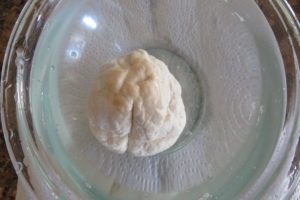
2. Sift the remaining flour with salt. Add sugar, half the butter, and enough milk. Knead to a soft dough but not too soft to make a slack dough.
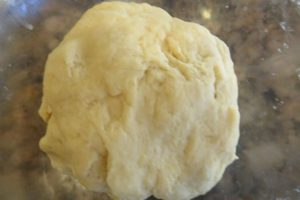
3. Place the dough on a pastry board, and knead until the dough is elastic and smooth.
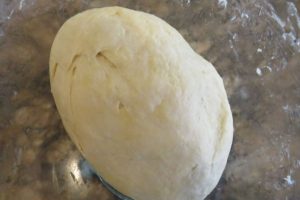
4. The yeast ball would have doubled in size in the large bowl. Drain it carefully using a slotted spoon until it stops dripping.
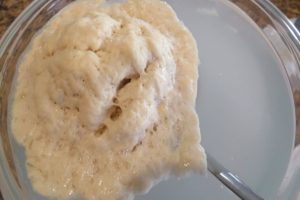
5. Gently cut the yeast ball and fold into the dough. Knead until the yeast ball is fully incorporated into the dough.
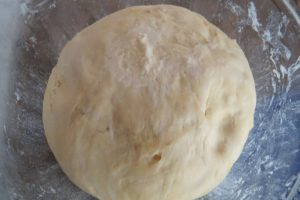
6. Cover with a moist towel and place a lid on the bowl. Refrigerate overnight.
7. The following day, fold two sheets of wax papers into a rectangle. Place the other half of the butter between the sheets of paper and gently roll over it. Roll the butter into a rectangle of even thickness.
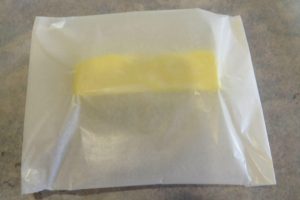
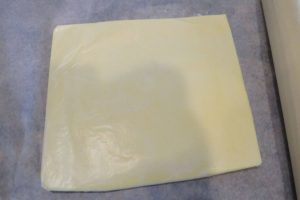
8. Remove the dough from the refrigerator. Turn it onto a floured board. Roll the dough to a rectangle, and place the rectangular butter in the center. Fold a third of the rolled dough on the butter.
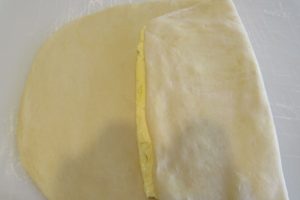
9. Fold the other third of the rolled dough over. Now, there will be three layers, two rolled dough layers and one butter layer. Roll and fold one third of it and bring the other third over the folded end.
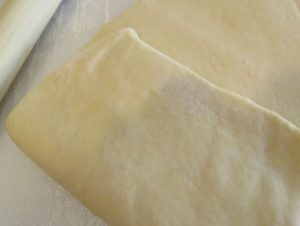
10. Turn the folded dough. This turn should made in such a way that the open end faces you. Roll out again, keep folding and then make a turn. Repeat the roll, fold, turn process at least three more times. Then, cover with a damp cloth and refrigerate for half an hour. Repeat the process of roll, fold, and turn, twice.
How to shape the croissants:
- Roll out the dough into a rectangle. Cut into rectangles lengthwise that can be cut further into two triangles by cutting diagonally.
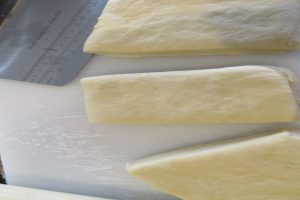
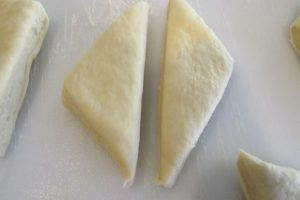
2. Roll the triangles into 1/8 ” . Make the top tip of the triangle as long as you can. Make a slit at the base so that you can curve the croissant like a “crescent”.
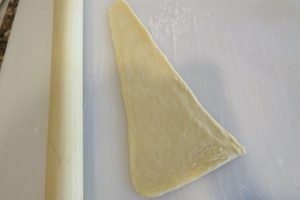
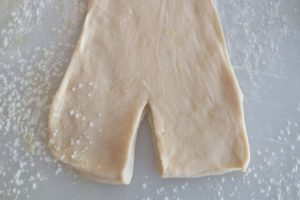
3. Starting from the base of the triangle, curl all the way up. Lightly flour a baking sheet, and place the croissants leaving at least 2″ between them. Cover with a cloth, and allow the croissants to prove for 30 minutes in a warm spot in the kitchen.
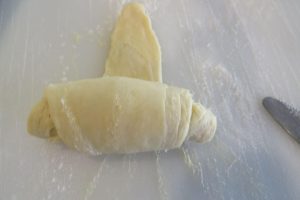
4. Brush with egg wash made of egg yolk beaten with cream or just cream. Bake in a pre-heated oven at 4250F for 5 minutes. Then, reduce the heat to 3750F, and bake the croissants for 10 minutes or until golden brown.
1.The temperature of your kitchen should be warm while making the dough and cool while rolling out the dough. This sounds a bit tricky but I ensure that my room temperature is at least conducive to helping the yeast rise and not letting the butter melt while rolling out. I adjust my thermostat accordingly.
2.While tucking the flattened butter in the dough (lamination), take extra care not to let the butter squeeze out. Folding as many layers helps make the pastry flaky.
3.Baking homemade croissants at a high temperature, and then reducing the heat and baking again helps the croissants become crunchy on the outside and soft on the inside.
4.Rolling the dough into a thin elongated triangle will give more layers as you roll from the base up.
5.Keep the dough cold, yet while rolling, ensure that you do it quickly so that the dough does not get warm and start fermenting.
6.Squared-off edges: When I first read this phrase, I was not quite clear on what to do. Over time, I learned that the butter must be flattened into a perfect rectangle (picture included) between two layers of wax papers. When aligning the butter block, make sure that the corners are well-tucked into the dough (image included below). Paying attention to this detail will help down the road to make sturdy and well-shaped croissants.
7. Finally, while cutting the pastry dough for each croissant, use a sharp knife or pastry cutter to make a straight cut and not drag or tear any of the layers. Clean-cut pastry will yield perfect looking croissants.
8. Last but not least, apply the egg wash made of egg yolk and cream or just cream carefully on the surface of the pastry and not on the layers, lest the open layers will stick together.
Other French breakfast and baked goods to try:
How to serve Homemade Croissants:
Enjoy these Homemade Croissants with Nutella or butter. My family goes nuts about these freshly baked croissants from scratch. Even though all these descriptions and instructions seem like a lot, they are only guidelines for you to get it right the first time. I have made every effort to walk you through the process by avoiding the mistakes I made earlier on when I first made croissants at home. Rectifying the errors will be purely rewarding as I can say it with conviction, that you will truly enjoy your homemade croissants and would include it into your regular menu.
How to store:
Fresh homemade croissants can be stored in airtight containers after cooling them completely for a week. They can be frozen for a couple of months if you have leftovers, but they do not taste them same as freshly baked ones.
Homemade Croissants
Equipment
- By hand; oven
Ingredients
- 16 oz bread flour (or all-purpose flour)
- ½ oz dry yeast
- 6-8 tbsp warm water tepid
- 1 tsp salt kosher or sea salt
- 5 tbsp granulated sugar
- 8 oz unsalted butter (preferably European butter)
- 12 tbsp whole milk
- 1 egg beaten, for brushing
Instructions
- Dissolve the yeast in the water. Then, add the yeast to a quarter of the flour and make a dough. The dough need not be too soft. Take a large bowl of warm water (hand hot) and put the yeast ball into it. Cut the ball on top before dropping into the bowl.
- Sift the remaining flour with salt. Add sugar, half the butter, and enough milk. Knead to a soft dough but not too soft to make a slack dough.
- Place the dough on a pastry board, and knead until the dough is elastic and smooth.
- The yeast ball would have doubled in size in the large bowl. Drain it carefully using a slotted spoon until it stops dripping. Do not squeeze or press down.
- Gently cut the yeast ball and fold into the dough. Knead until the yeast ball is fully incorporated into the dough. Cover with a moist towel and place a lid on the bowl. Refrigerate overnight.
- The following day, fold two sheets of wax papers into a rectangle. Place the other half of the butter between the sheets of paper and gently roll over it.
- Roll out to make a rectangle out of the butter that is of even thickness and remove the wax paper.
- Remove the dough from the refrigerator. Turn it onto a floured board. Roll the dough to a rectangle and place the rectangular shaped butter in the center. Fold a third of the rolled dough on the butter.
- Fold the other third of the rolled dough over. Now, there will be three layers, two rolled dough and one butter layer in between them. Roll and fold one third of it and bring the other third over the folded end.
- Turn the folded dough. This turn should made in such a way that the open end faces you. Roll out again, keep folding and then make a turn. Repeat the roll, fold, turn process at least three more times. Then, cover with a damp cloth and refrigerate for half an hour. Repeat the process of roll, fold, and turn twice.
How to shape the croissants:
- Roll out the dough into a rectangle. Cut into rectangles lengthwise.
- Cut the rectangle pieces further into two triangles diagonally.
- Roll the triangles into 1/8 " . Make the top tip of the triangle as long as you can.
- Make a slit at the base so that you can curve the croissant like a "crescent".
- Starting from the base of the triangle, curl all the way up. Lightly flour a baking sheet and place the croissants leaving at least 2" between them. Cover with a cloth and allow the croissants to prove for 30 minutes in a warm spot in the kitchen.
- Brush with egg wash made of egg yolk beaten with cream or just cream. Bake in a preheated oven at 425 degrees F for 5 minutes. Then reduce the heat to 375 degrees F and bake the croissants for 10 minutes or until golden brown.
Notes
- Care must be taken to follow every step in making these croissants at home. The taste and texture of the croissants will be far better than the store-bought ones. They will be worth your while.
- Bread flour yields the best results. (see blog post)
Nutrition



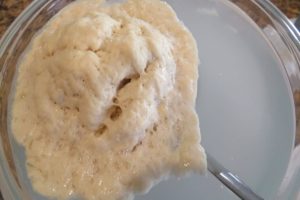





















Great recipe! The croissants turned out amazing when I tried this at home, thank you!
great recipe!